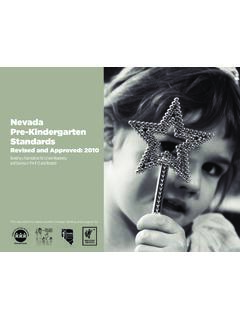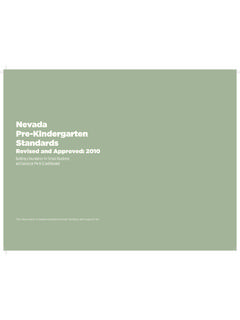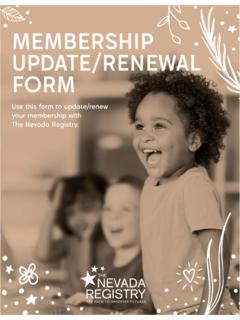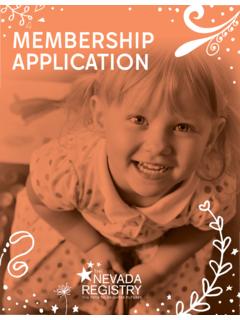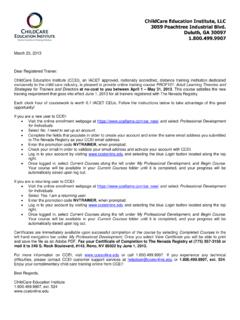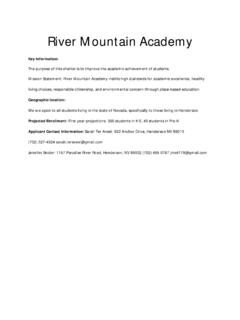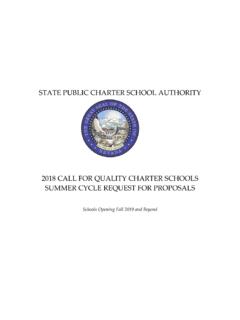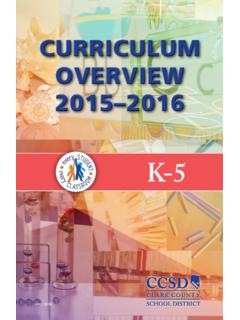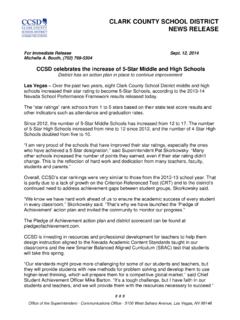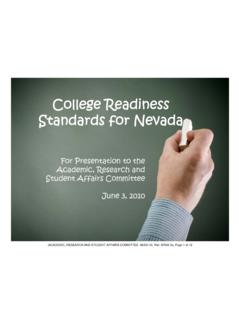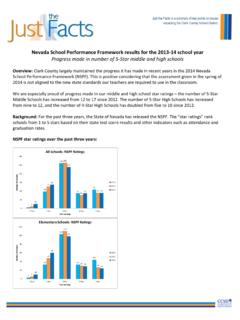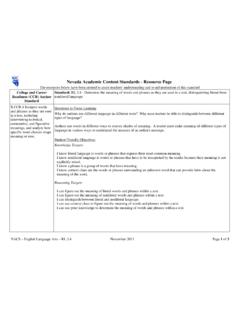Transcription of Nevada Early Childhood Crosswalk - The Nevada Registry
1 Nevada Early Childhood Crosswalk A supplemental document between the Nevada Pre-K standards and Nevada academic content standards TABLE OF CONTENTS. Acknowledgments .. 1. Introduction .. 2. Mathematics .. 3. English Language Arts .. 8. Resources for Educators .. 23. Resources for Parents .. 24. ACKNOWLEDGEMENTS. The Nevada Department of Education would like to thank the following work groups and the writing committee for their hard work and contribution to this document. This document has been designed to be a useful tool to help Pre-K and Kindergarten teachers have an aligned Crosswalk that demonstrates how the Nevada Pre-K standards are aligned with Common Core State standards now known as the Nevada academic content standards .
2 The Crosswalk will provide a deeper understanding on how the two standards align. Teachers will find the documents helpful with planning and implementing the standards into their curriculums. WORK COMMITTEES. Carson City School District Community HELPS. Elko County Early Childhood Advisory Council Great Basin College Nevada Pre-K standards & Early Learning Guidelines Washoe County Pre-K-Third Early Childhood Advisory Council UNR College of Education Faculty State Department of Education 1. Nevada Pre-Kindergarten standards Common Core Crosswalk A Supplement to the Nevada Pre-Kindergarten standards This document is not to be used as an unconnected list of Pre-K standards .
3 This document should be used in conjunction with the 2010 Nevada Pre-Kindergarten standards document. The revised Pre-Kindergarten standards document provides examples of how the standards may be displayed in the classroom and provides examples of related activities that professionals may use to provide meaningful, developmentally appropriate experiences to enhance children's knowledge related to the respective standard. In 2011, the State of Nevada adopted the Common Core State standards and which has now become the Nevada academic content standards (NVACS) that are based on the Common Core State standards . The Early Childhood community saw the need to align the grade levels with these standards .
4 In 2010, stakeholders from across the state met to review and revise the state's PreK standards ( Nevada Pre-Kindergarten standards ; Revised and Approved 2010). In 2012, a discussion began about how to align these two documents to have Early Childhood educators focus more on the domains that students need to master---even what is expected of those students later on in kindergarten and first grades---and not to focus so much on the individual standards or objectives. This is a challenge because in K-12 we tend to look at just individual grade level standards . But we need to begin to ask ourselves and our P-3 teachers: Just what does it look like for five- and six-year-olds to be ready for school across all FIVE domains of learning?
5 As a result of this gap and the growing support for P-3 approaches nationally and within the state, a couple of local Early Childhood Advisory Councils (ECACs) partnered together with the Nevada ECAC to begin to develop this comprehensive Crosswalk between the Nevada Pre-K and the Common Core State standards (CCSS) to help bridge this gap. This Crosswalk is designed to show PreK. teachers how they are building the foundation for what happens in Kindergarten, and demonstrates to the Kindergarten teachers what Pre-K standards are directly linked to in the many CCSS across all domains of learning. This supports the notion for everybody to now be looking at the whole child versus an individual skill, with all P-3 teachers on the same page.
6 The National Association for the Education of Young Children (NAEYC) and the National Association for Early Childhood Specialists in State Departments of Education (NAECS-SDE) recently have recently published a document that articulates four conditions under which Early learning standards should be developed and implemented. Comparing these conditions against the development and implementation of the Common Core may provide avenue for Early education and K-12 education systems to become more closely aligned in purpose. These four conditions include: 1) Early learning standards should emphasize significant developmentally appropriate content and outcomes; 2) Early learning standards are developed and reviewed through informed, inclusive processes; 3) Early learning standards gain their effectiveness through implementation and assessment practices that support children's development in ethical, appropriate ways; and 4) Early learning standards require a foundation of support for Early Childhood programs, professionals, and families.
7 These four conditions were reviewed when compiling this document (The Common Core State standards : Caution and Opportunity for Early Childhood Education; NAEYC, 2011). It is important to note that the Nevada academic content standards and the Pre-K standards may not be an exact match. Rather, the point of this document is to show how the Pre-K standards provide the foundation for the Common Core across all domains of learning, and are aligned accordingly. 2. MATHEMATICS Domains: Counting and Cardinality (CC); Operations and Algebraic Thinking (OA); Measurement and Data (MD); Geometry (G) Pre- Kindergarten Standard Common Core Kindergarten Standard Recognize and read numerals 0- 5.
8 Write numbers from 1 to 20. Represent a number of objects with a written numeral 0- 20 (with 0 representing a count of no objects). Compare two numbers between 1 and 10 presented as written numerals. Estimate the number of objects in Understanding the relationship between numbers and quantities; connect counting to a set of 5 and verify by counting. cardinality. a) When counting objects, say the numbers in the standard order, pairing each number name with one and only one object. b) Understand that the last number said tells the number of objects counted. The number of objects is the same regardless of their arrangement or the order in which they were counted.
9 C) Understand that each successive number name refers to a quantity that is one larger. Count to answer how many questions about as many as 20 things arranged in a line, a rectangular array, or a circle, or as many of 10 things in a scattered configuration; given a number from 1- 20, count out that many objects. Write numbers from 1 to 20. Represent a number of objects with a written numeral 0- 20 Match the number of objects in a (with 0 representing a count of no objects). set to the correct numeral 0 to 5. Solve addition and subtraction word problems, and add and subtract within 10, , by using objects or drawings to represent the problem. Fluently add and subtract within 5.
10 Count to 100 by ones and tens. Count to 10. Count forward beginning from a given number within the known sequence (instead of having to begin at 1). Understanding the relationship between numbers and quantities; connect counting to cardinality. d) When counting objects, say the numbers in the standard order, pairing each number name 3 3. with one and only one object. e) Understand that the last number said tells the number of objects counted. The number of objects is the same regardless of their arrangement or the order in which they were counted. f) Understand that each successive number name refers to a quantity that is one larger. Count to answer how many questions about as many as 20 things arranged in a line, a rectangular array, or a circle, or as many of 10 things in a scattered configuration; given a number from 1- 20, count out that many objects.
